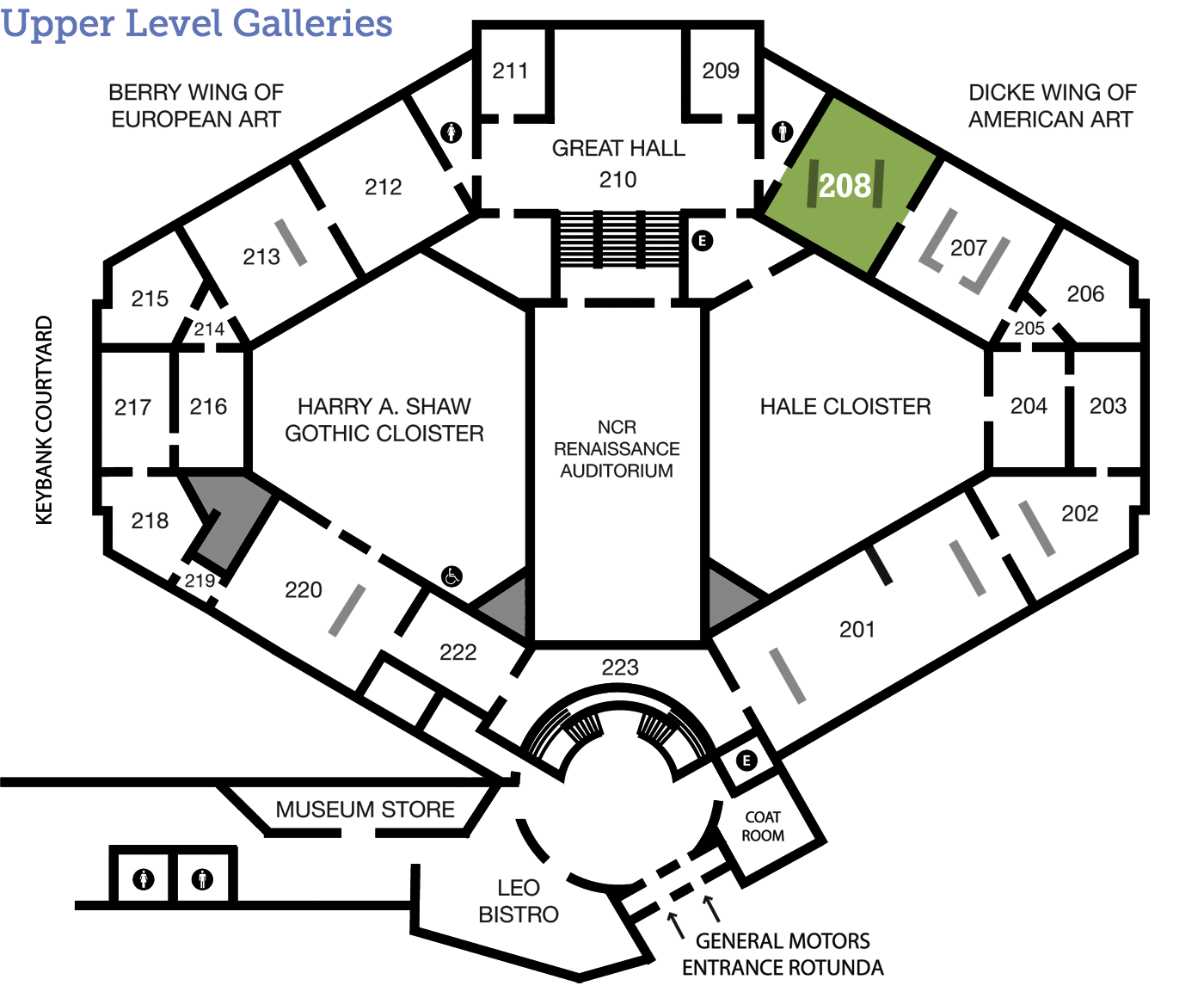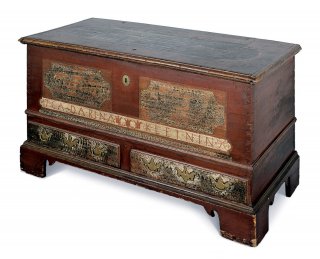
American
Blanket Chest
American Poplar, painted with brass pulls Gift of the Estate of Mr. Elmer R. Webster and Mr. Robert A. Titsch 1995.52 208
Antique vs. IKEA
Do you keep your clothes and personal belongings in a piece of furniture? How long have you used it? Would you put it in a museum? Reconsider your personal relationship with furniture through this simple and sturdy piece of early American craftsmanship.
A Day in the Life
That’s Mine!
Lift-top chests like this were the most important piece of storage furniture for German immigrants. Each person in the household had their own and they held clothing, bedding, and some personal belongings, including money. During their teenage years both girls and boys would receive a chest that would then be taken with them when they left home. While these chests have often been described as “dower” or “hope” chests, they would not necessarily have been made for a young woman’s marriage; rather, it was part of the marriage furniture because it was her own possession. What other information can we learn from the chest itself? Take the following quiz to find out.
Quiz
Question 1: The numbers 17 90 refer to:
The owner’s birthday.
The year the chest was made.
The year of the owner’s wedding.
Question 2: The letters CA DARINA KLEININ refer to:
A trendy chest maker in southeastern Pennsylvania.
The last names of the owner and her/his spouse
The name of the owner
Tools and Techniques
Holding It Together
Throughout the 18th century many Germans immigrated to America and settled in southeastern Pennsylvania. They brought with them lift-top storage chests, a simple and essential household furnishing. German Americans continued to make these chests, but they developed their own unique style that also drew on elements of English cabinetmaking.
Tap on the different parts listed below to see detailed images and learn more.
Joinery
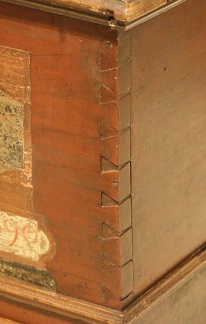 The main box is made of one-piece boards that are joined with dovetailing. The bracket supports, which also use dovetailing, give a lightness to the chest more typical of English cabinetmaking.
The main box is made of one-piece boards that are joined with dovetailing. The bracket supports, which also use dovetailing, give a lightness to the chest more typical of English cabinetmaking.
Interior
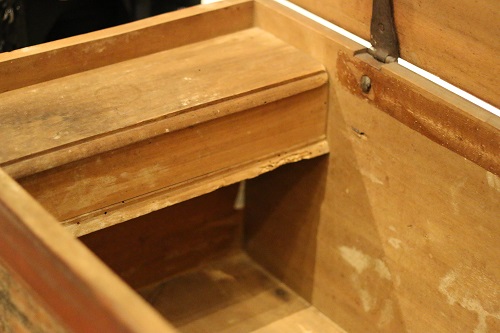 The inside contains a small built-in box, called a “till,” used for storing small items. Some chests have an additional hidden drawer covered by a false front that slides up.
The inside contains a small built-in box, called a “till,” used for storing small items. Some chests have an additional hidden drawer covered by a false front that slides up.
Hinges
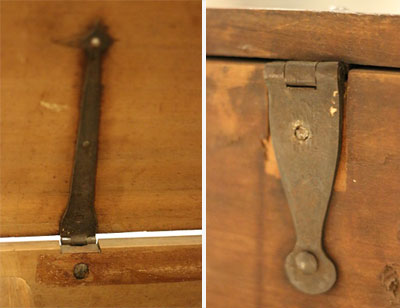 Most chests, like this one, use iron hinges that are attached to the outside of the back of the chest and the inside of the lid. Hinges could be made from a hammered bar of iron or cut from sheet metal. Likewise, they could be purchased from a local blacksmith or from larger merchants.
Most chests, like this one, use iron hinges that are attached to the outside of the back of the chest and the inside of the lid. Hinges could be made from a hammered bar of iron or cut from sheet metal. Likewise, they could be purchased from a local blacksmith or from larger merchants.
Pulls
 The brass drawer pulls and keyhole plates exemplify a popular pattern found on many other chests. They were imported from England. The pulls are attached by screws held in place by round nuts that lie below the surface of the inside of the drawer in recessed holes, creating a smooth finish.
The brass drawer pulls and keyhole plates exemplify a popular pattern found on many other chests. They were imported from England. The pulls are attached by screws held in place by round nuts that lie below the surface of the inside of the drawer in recessed holes, creating a smooth finish.
Lock
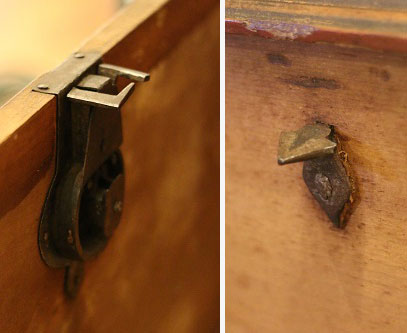 The lock on this chest is known as a crab lock, and is found on many other chests. A spring mechanism holds the arrow-shaped metal drop secure with two crab-like claws. Turning a key inserted in the keyhole forces open the arms, releasing the metal drop so the lid can be lifted.
The lock on this chest is known as a crab lock, and is found on many other chests. A spring mechanism holds the arrow-shaped metal drop secure with two crab-like claws. Turning a key inserted in the keyhole forces open the arms, releasing the metal drop so the lid can be lifted.
Further reading: Monroe H. Fabian, The Pennsylvania German Decorated Chest (New York: Universe Books, 1978).
Behind the Scenes
Look Closer
A Custom Finish
Painting was a popular way of decorating and protecting chests made of soft woods like pine and tulip poplar. Some have elaborate designs and figures, such as unicorns, birds, and flowers. This chest has three simple tulips on the front.
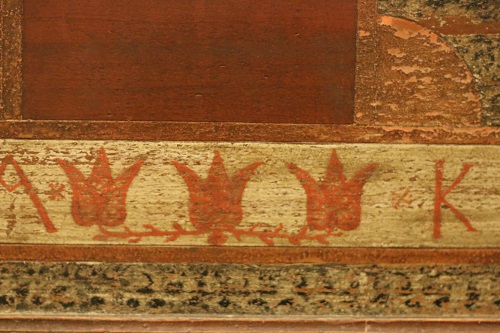
Detail, front
However, despite the subdued graphics a variety of techniques were used to give this chest a unique look. First, patterns for different sections were scribed into the wood with a sharp tool before painting, creating a crisp outline.
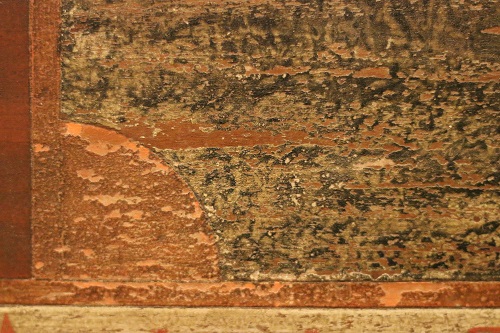
Detail, front
Second, a technique known as texturing created an interesting surface and color. Texturing was done by painting over a first layer of paint with a contrasting color and, while the second color was still wet, running a hard object across the surface, such as a brush, corn cob, or feather. You can still see this two-tone effect in places on this chest.
Just for Kids
Imagine!
Throughout the 1700s, many Germans immigrated to the United States and settled in Pennsylvania. Blanket chests, like this one, were prize possessions for immigrants. The chests were given to teenagers, and filled with their clothes, bedding, and other personal belongings.
If you were immigrating to a new country, and given only a blanket chest what would you fill it with? Think about what you would want versus what you would need. Do any of these things overlap?
Signs & Symbols
Dig Deeper
Arts Intersected
The Sculpture Speaks
Did You Know?
Expert Opinion
Look Around
Wedding in a Box
Although this chest was not made specifically for the owner’s wedding, she would have taken it with her when she moved to her new home if she got married. One object in The DAI’s collection that was made for a wedding is Judith and Holofernes, located in Gallery 220. The painting is actually the front panel of an Italian wedding chest known as a cassone. Compare the fronts of the two chests. Do you find yourself more engaged by one or the other? Consider why this may be.

The Master of Marradi (Italian, Florentine, active 15th century), Judith and Holofernes, 15th century, tempera on wood panel, 15¾ x 58½ inches. Gift of Mr. and Mrs. Ralf Kircher, 1964.10.
About the Artist
Talk Back
Better with Age
This chest is not perfect. It shows wear from many years of daily use in household life. What kind of positive qualities does wear give to an object? Do you have a particular object you treasure for its faithful service over time?

